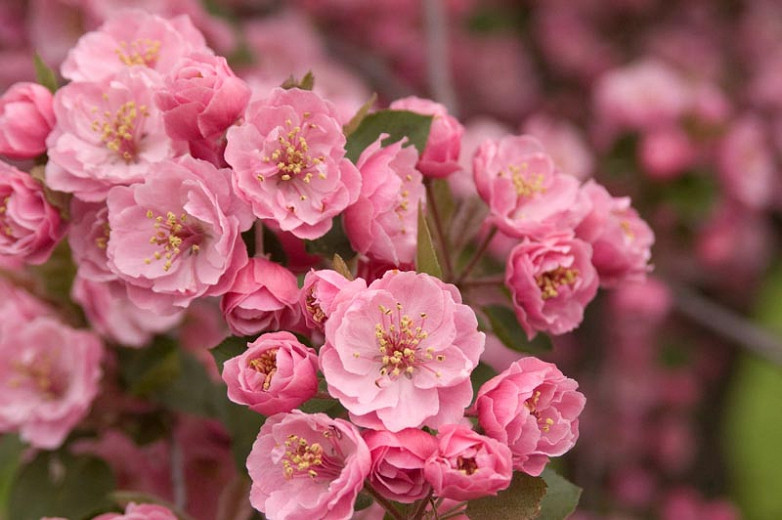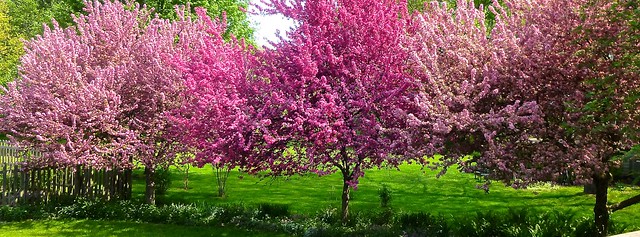We’ve all sunken our teeth into a tiny crabapple, hoping it would be tasty. Then, almost always, it is a nasty, sour experience that we don’t want to repeat. Can something that puckers so badly be good for people to eat? The Old English word “crabbe” means “bitter” or “sharp.” What is the relationship between these sour crabapples and tasty, commercial apples?.
Come springtime, crab apple trees burst into bloom with beautiful and fragrant flowers Have you ever wondered if you can eat crab apple blossoms? While the sour fruit of crab apples isn’t too appetizing, the flowers are actually quite delightful!
Keep reading to learn all about enjoying these edible spring blooms and how to identify crab apple trees.
An Overview of Crab Apple Trees
Crab apple trees belong to the genus Malus, along with domesticated apple trees. There are over 45 species of crab apples native to Asia, Europe, and North America.
Popular ornamental varieties include:
- Siberian crab apple (Malus baccata)
- Japanese crab apple (Malus floribunda)
- Prairie crab apple (Malus ioensis)
- Southern crab apple (Malus angustifolia)
Crab apples are smaller than domesticated apples, typically under 2 inches in diameter. The fruits are very tart due to high levels of malic acid. While edible, they have limited culinary uses compared to true apples.
However, crab apple trees are grown commercially to pollinate apple orchards. Their abundant blossoms provide the pollen apple trees need for fruit production.
Identifying Crab Apple Trees
Here are some tips for identifying crab apple trees
-
Location – Crab apples are found throughout temperate regions of the Northern Hemisphere. In North America, they grow wild from Canada to Mexico.
-
Size – Crab apples are relatively small, growing 15-30 feet high. Some weeping and dwarf varieties are under 10 feet.
-
Bark – Maturing crab apples develop scaly, grayish-brown bark with ridges and furrows.
-
Flowers – Abundant spring blooms emerge before leaves form. Flowers come in white, pink, and red hues.
-
Fruit – Green, yellow, or red crab apples mature in late summer/fall. They are quite small and sour.
-
Leaves – Alternate, simple leaves have an oval shape with serrated edges. Leaves turn yellow to red in fall.
Are Crab Apple Blossoms Edible?
Yes! Crab apple blossoms are entirely edible and make a lovely edible garnish. The flavor is mildly sweet with notes of nectar and pollen.
Crab apple flowers can be eaten right off the tree. Gently pluck blossoms to avoid damaging developing fruit. Rinse well.
Popular ways to enjoy crab apple blooms:
- Salads – Scatter over green salads or fruit salads
- Drinks – Float in lemonade, teas, and cocktails
- Desserts – Use as a cake topping or mix into ice cream
- Snacks – Skewer in kebabs with berries and cheese
- Savory dishes – Garnish soups, omelets, and pasta
- Preserved – Pickle in vinegar for year-round use
Safety Tips for Eating Crab Apple Flowers
Crab apple trees are not toxic. However, be aware of the following when foraging:
- Allergies – Avoid if you have pollen allergies.
- Pesticides – Do not harvest from trees treated with chemicals.
- Identification – Positively identify tree as an edible Malus species.
- Quality – Harvest fresh, young flowers free of insect damage.
- Quantity – Eat in moderation as crab apples can cause digestive upset.
The Multiple Benefits of Crab Apple Trees
Beyond providing edible blossoms, here’s why crab apples deserve a spot in your landscape:
-
Ornamental beauty – Pretty flowers and interesting fruit for visual interest. Great for borders and focal points.
-
Pollination – Provide essential pollen for apple, pear, and other fruit trees.
-
Wildlife habitat – Food source for birds and mammals. Nesting sites for songbirds.
-
Deer resistance – Unpalatable to deer due to tart apples.
-
Diversity – Genetic diversity supports ecosystem and food web health.
-
Native character – Naturalized crab apples preserve native plant heritage.
Get Out and Enjoy Some Crab Apple Blossoms!
Crab apple blooms herald the arrival of spring with their delicate beauty and sweet flavor. Next time you come across these flowering trees, don’t be afraid to sample a few blossoms! Just be sure to positively identify crab apples and harvest responsibly.

How Did Apples Come to Be?
All of our farmed foods originally came from a totally wild, undomesticated species. Apples are no different. Believe it or not, all of the apples in our grocery stores originally came from crabapple trees. Technically, apples are a type of crabapple, rather than the other way around.
Apples and crabapples reside in the genus Malus. In Latin, this word means evil or wrongdoing, referring to Adam and Eve in the Garden of Eden. There are at least 45 species of trees in the Malus genus. These trees are native to many cooler places in the northern hemisphere, from the U. S. to Pakistan to China.
All of these tree species are crabapples, except for Malus domestica. M. domestica is the big, juicy, sweet cultivated apple. Granny Smith, Red Delicious, Honeycrisp, and Fuji are all varieties of M. domestica. Researchers constantly create new varieties of apples from this one species.
People in central Asia began to breed the Malus sieversii species of crabapples 4,000 to 10,000 years ago. Through time, they were able to coax sweetness into the fruit and sourness out of the fruit. They also chose trees with bigger fruits, resulting in much larger apples over time.
Eventually, this tree differentiated from M. sieversii enough to be considered a different species. M. sieversii still grows in the wild in central Asia. However, humans didn’t stop with selectively breeding M. sieversii.

What Is the Purpose of Crabapple Trees?
Instead of being grown for food, crabapple trees are generally grown for their beauty. Historically, humans took a liking to a handful of these species, selecting for their bright, abundant flowers. Domesticated crabapple trees have beautiful spring blooms and come in many shapes and colors, but their wild counterparts aren’t as tasty.
The larger gene pool in crabapples allows for more genetic variation, so these trees vary in shape, blossom color, hardiness, and fruit color. Check out how many varieties there are! They can be bushy, weeping, spreading, straight, or anything in between. The blossoms can be anywhere from white to bright pink, and the fruit anywhere between green, orange, yellow, red, and pink. This stunning and aesthetically appealing variation has earned crabapples the title ‘Jewels of the Landscape.’
Flowering Crabapple – Edible Crabapple Fruit – Flowering Crab Apple – Malus species
Are crabapples edible?
So crabapples are extremely valuable from a commercial farming perspective, even though they can’t sell their apples. It’s likely that you can thank crabapple trees for the apples in your fruit basket! Let’s Get to the Bottom of This, Are These Sour Apples Edible? Yes. They are absolutely edible, but they aren’t very tasty.
What does a crabapple tree taste like?
Crabapple trees produce small fruits called crabapples that generally have a tart taste. The colorful miniature apples often stay hanging on the tree long after the leaves have dropped in the fall. Crabapple trees (botanical name Malus) are like miniature apple trees ( Malus domestica ).
Are crab apples safe to eat?
Crab apple trees are common backyard plants. It’s common to wonder if the tiny apples from these trees are safe to eat. What Are Crab Apples? Crab apples are miniature apples made by flowering crab apple trees. These trees are excellent pollinators, and their fruit feeds many kinds of wildlife.
Are apples a crabapple?
Apples are no different. Believe it or not, all of the apples in our grocery stores originally came from crabapple trees. Technically, apples are a type of crabapple, rather than the other way around. Apples and crabapples reside in the genus Malus. In Latin, this word means evil or wrongdoing, referring to Adam and Eve in the Garden of Eden.
